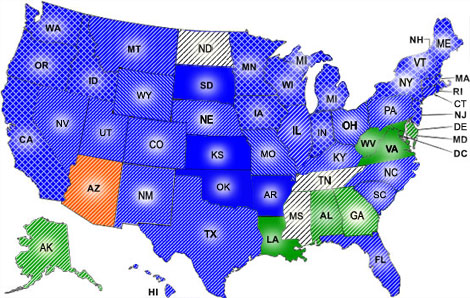With the unbundling of electric services at the heart of deregulation, electric utilities were uncertain about their ability to recover stranded investments in electricity infrastructure. As a result, many utilities delayed infrastructure investments in new generation and transmission, leading to local or regional transmission bottlenecks and areas with inadequate generating capacity.
Demand-response programs, which encourage electricity consumers to reduce energy use during system peak periods in exchange for lower electricity bills, can mitigate both problems. There are two types of demand-response programs.
Load Response
With these programs, a load reduction is called for by a utility company, with little discretion in compliance on the part of the electricity consumer. Utilities that may call for a load response include independent system (grid) operators, load-serving entities, and utility distribution companies.
There are three types of load response programs:
- Direct load-control programs — Primarily for residential and small commercial facilities with equipment, such as air conditioners that may be “cycled” (turned off) for limited periods.
- Curtailable load programs — Primarily for extensive commercial and industrial facilities that can reduce at least some load with a minimum threshold, such as 100 kW per event. Notification is generally from 30 minutes to two hours before the requested curtailment.
- Interruptible programs — Primarily for industrial operations that can shed all or significant portions of their load. Commercial facilities may also participate if backup generators provide significant portions of the load.
Price Response
Price response programs operate based on the voluntary actions of electricity customers in response to market signals. They typically rely on wholesale clearing prices as a primary signal or method to reimburse customers for their participation. Price-responsive demand helps mitigate spikes in wholesale market prices.
Price response programs include the following:
- Economic programs — Primarily for extensive commercial and industrial facilities that can provide a minimum amount of load reduction, such as 100 kW per event. Participants may offer load reductions in specific amounts for specific periods in response to a proposed price or set of hourly prices in the day-ahead market (or potentially the hour-ahead or real-time market). Payment is based on the market-clearing price in the day-ahead market bid by the participant and accepted by the buyer for day-ahead programs.
- Time-of-use rates — Eligible customers may be residential, commercial, or industrial users. Participation may be mandatory or voluntary, depending on the jurisdiction. Special meters are installed to measure consumption during peak, off-peak, and sometimes intermediate hours. Rates vary with time of day, day of the week (since weekends are generally considered off-peak), and year’s season (since winter weekdays may be considered off-peak or intermediate hours). Rates are fixed for each period, so the customer knows well in advance what the prices will be.
- Absolute time pricing — Primarily for commercial and industrial facilities that can reduce or shift loads. Advanced communication systems allow electricity customers to observe real-time energy usage and forward prices. In one version, customers are provided hourly prices for the next day. Facility managers can maintain operations as planned or adjust operations to take advantage of lower rates. “Two-part” tariffs establish a baseline energy usage for each hour of the year. Baseline usage is agreed upon by both parties based on historical use subject to appropriate adjustments, such as changes in operations or weather. Variances in usage from baseline estimates are charged a premium if above and a discount if below the baseline using spot market clearing prices. An alternative to the two-part tariff is a “one-part” tariff that links all usage to hourly prices to market clearing spot prices and avoids baseline estimation.
Experience with regional power markets suggests that active demand response is crucial to power system reliability and market efficiency.
See the following for more information:
- States with demand response programs — Includes an overview map and detailed state-by-state descriptions.
- “Demand Response Helps ISOs Lighten Load” (PDF 196 KB). Download Acrobat Reader:— Transmission Insight, April 2002. The article is on page nine of this free sample issue.
- Dimensions of Demand Response (Word 1.1 MB) — New England Demand Response Initiative, July 2003.
- Electrical Load as a Reliability Resource
- Peak Load Management Alliance — An organization that investigates the role of demand response in creating efficient electricity markets.
- Examples of demand response programs
- EERE documents on the subject of rate schedules.
Select a state below to access more detailed information about that state’s programs.
Legend
| [Blue] | These states have public purpose and utility energy efficiency programs and demand response/load management programs. |
| [Green] | These states have demand response/load management programs. |
| [Orange] | These states have a public purpose and utility energy efficiency programs. |
 |
These states have distributed energy resource options available. |
 |
These states have gas energy efficiency programs. |
| [White] | These states have no energy management programs. |

Note
The energy management programs are categorized according to the following definitions:
- Energy Efficiency Programs: Can be either 1) public purpose programs which are administered either by utilities, state agencies, or other third parties and are paid for by utility ratepayers, typically through a non-bypassable System Benefits Charge which is instituted as part of restructuring legislation or rules or 2) utility programs administered by the local utility and paid for by utility ratepayers through their bundled rates.
- Demand Response Programs/Load Management: Programs provide incentives to curtail demand and reduce load during peak periods in response to system reliability or market conditions.